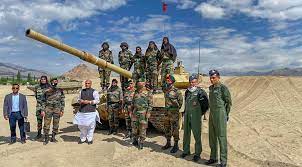To deal with emerging threats and the changing nature of modern day warfare, the Indian Army is expediting its process of modernisation of its armoured wing. It is soon going to induct it’s indigenously designed and developed Light Tank `Zorawar’.
The Indian Army felt the urgent need to have Light Tanks in service to gain operational dominance in High Altitude Areas (HAA) over its adversary – China in 2020, following the aggression of the Chinese troops as they made advances towards Pangong Tso and then the Indian Army had surprised the Chinese in the South of Pangong Tso by occupying some heights.
Why does the Indian Army need light tanks?
In the terrain along the Line of Actual Control (LAC) in eastern Ladakh, the Indian Army had to deploy heavier tanks like the T-72 which weighs around 45 tonnes and T-90 with a weight of around 46 tonnes, in the absence of light tanks. Both these tanks are not meant for high altitude areas. Rather they are good to be deployed in deserts and plains.
In 2021, the Indian Army had issued a Request for Information (RFI) for procuring 350 Light Tanks with a weight of less than 25 tonnes – with a margin of 10 percent and same fire power as the regular tanks. These tanks are to be deployed in High Altitude Areas (HAA) to counter Chinese deployment of similar armoured columns along the LAC.
According to sources in the defence and security establishment, next month the Indian Army which has already finalized its Staff Quality Requirements (SQR) will approach the Ministry of Defence for the Acceptance of Necessity (AoN). This is the first step to get the project started.
What is the Indian Army looking for?
“These Indian Light Tanks (ILT) should be armed with Artificial Intelligence (AI), integration of tactical surveillance drones which will provide a high degree of situational awareness. And also loitering munitions, with an active protection system,” said the source quoted above. Adding, “An active protection system is designed to protect vehicles from anti-tank guided missiles and projectiles away from combat vehicles.
All you want to know about Project `Zorawar’
This project of Light Tanks has been named after Zorawar Singh Kahluria, who was a military general. He had served under Jammu’s Raja Gulab Singh, who according to officials is known as the ‘conqueror of Ladakh’.
It has been designed in such a way that it will be able to operate in varying terrain from High Altitude Area, island territories as well as marginal terrain.
The Army also wants the light tank to be amphibious, so it can be deployed across riverine regions and even the Pangong Tso Lake in Eastern Ladakh.
Also Read: Defence projects under Make-I, Make-II get approval; Light tanks for Indian Army to be made in India
To meet any operational requirements, these can be deployed rapidly.
India’s adversaries both Pakistan and China have already inducted state-of-the-art tanks, which are technologically advanced and have a mix of medium weight as well as Light Tanks with high power to weight ratios.
Threat on the Northern Border
As a result of the threat on India’s Northern Border to remain in the foreseeable future, there is an urgent need for the Indian Army to be ready with their own indigenous Light Tanks which can be deployed faster in case of operational requirement.
Financial Express Online has reported earlier that in-principle approval has already been given for these tanks and the industry is already working on building such a tank based on the specifications stated by the Indian Army.
Future Tanks
According to sources, the Indian Army has been working on future tanks which are expected to replace the existing tanks and by 2020 the first prototype will be ready.
Impact of the ongoing Russia-Ukraine War
Due to the ongoing war between Russia and Ukraine, the world supply chain in defence related component supply has been hit with delays. “This has impacted the maintenance, manufacturing and sustenance of the Foreign Fleet of tanks in the Indian army. Therefore, there is an urgency to design and develop indigenous Light Tanks in India,” said the source.
New Challenges for the Indian Army
Indian army is looking for versatility & flexibility of light and medium platforms — Armoured Fighting Vehicle-Indian Light Tank (AFV-ILT) which offers capability for multiple employment options and comes with niche technologies as an operational imperative.
Lightweight platform
Agile platform which has high power to Weight ratio, protection, surveillance, substantial firepower, and communication capabilities. This will help the Indian Army to execute operations in different terrain and also in diverse threat and equipment profile of the adversaries.
The MoD has plans to procure `AFV-ILT’ catering to the requirements of the Indian Army including Engineering Support Package and other Maintenance and Training. These will be under the `‘Make-I’ acquisition category’ of the Defence Acquisition Procedure (DAP) – 2020 in line with ‘Atam Nirbhar Bharat’ and ‘Make in India’ concept.
Light Tanks as Force Multipliers
Since 1982 the need for the Light Tank is being projected several times by the Indian army. These Light Tanks have been employed as Force Multipliers in different battle engagements including: in Battle of Kohima in World War II when Stuart Tanks of 254 Indian Tank Brigade were deployed; in the Indo-Pak war 1947-48 — in Naushera, Jhangar, Rajauri & most successfully at Zojila; in 1962 AMX-13 tanks at Chushul & Bomdila; in 1965 AMX-13 tanks at Chammb &in 1971 the amphibious PT-76 light tanks with the PT-76 tanks leading the race to Dacca.
Also, according to sources, in the 1980s the AMX-13 and PT-76 tanks were phased out and the focus shifted to the Western Borders. This resulted in the conversion of PT-76 units to T-72 profile.
